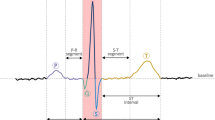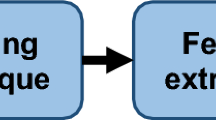Abstract
Electrocardiogram (ECG) is the most effective instrument for making decisions about various forms of heart disease. As a result, several researchers have focused on the ECG signal to extract the features of heartbeats with high precision and efficiency. This article offers a hybrid approach to classifying different cardiac conditions using the Feed Forward Back Propagation Neural Network (FFBPNN), by providing a pre-processed ECG signal as an excitation. The modified ECG signal is obtained through the combination of EMD (Empirical Mode Decomposition) and DWT (Discrete Wavelet Transform). In this proposed method, the input signal is first decomposed into the Intrinsic Mode Functions (IMF's) and the first three IMF's are combined to obtain a modified partially denoted ECG sample and then DWT is used to obtain an improved denoised signal. This pre-processed signal is classified using the Neural Network architecture. For the EMD approach, the ECG-based EMD-DWT signal provides improved classification accuracy of 67, 0762 percent, 90, 4305 percent for the DWT approach, and 95,0797 percent for the proposed technique. The methodology is applied to the MIT-BIH database and, in terms of classification accuracy, is found to be higher than the different methodologies.






Similar content being viewed by others
References
Hasan NI, Bhattacharjee A (2019) Deep learning approach to cardiovascular disease classification employing modified ECG signal from EMD. BSP&C 52:128–140. https://doi.org/10.1016/j.bspc.2019.04.005
Singh R, Mehta R, Rajpal N (2018) Efficient wavelet families for ECG classification using neural classifiers. Proced Comput Sci 132:11–21. https://doi.org/10.1016/j.procs.2018.05.054
Geetha PK, Nidhya R, Kumar AD, Selvi KT (2014) Cell segmentation and nc ratio analysis for biopsy images using marker controlled watershed algorithm. In 2014 International Conference on Green Computing Communication and Electrical Engineering (ICGCCEE) (pp. 1–5). https://doi.org/https://doi.org/10.1109/ICGCCEE.2014.6921396
Alarsan FI, Younes M (2019) Analysis and classifcation of heart diseases using heartbeat features and machine learning algorithms. J Big Data. https://doi.org/10.1186/s40537-019-0244-x
Soudani A, Almusallam M (2018) Atrial fibrillation detection based on ECG-features extraction in WBSN. Proced Comput Sci 130:472–479. https://doi.org/10.1016/j.procs.2018.04.052
Diker A, Avci D, Avci E, Gedikpinar M (2019) A new technique for ECG signal classification genetic algorithm Wavelet Kernel extreme learning machine. Optik 180:46–55. https://doi.org/10.1016/j.ijleo.2018.11.065
Al Rahhal MM, Bazi Y, AlHichri H, Alajlan N, Melgani F (2016) Yager RRDeep learning approach for active classification of electrocardiogram signals. Inf Sci 345:340–354. https://doi.org/10.1016/j.ins.2016.01.082
Shadmand S, Mashoufi B (2016) A new personalized ECG signal classification algorithm using Block-based Neural Network and Particle Swarm Optimization. Biomed Signal Process Control 25:12–23. https://doi.org/10.1016/j.bspc.2015.10.008
Afkhami RG, Azarnia G, Tinati MA (2016) Cardiac arrhythmia classification using statistical and mixture modeling features of ECG signals. Pattern Recogn Lett 70:45–51. https://doi.org/10.1016/j.patrec.2015.11.018
Hanbay K (2016) Deep neural network based approach for ECG classification using hybrid differential features and active learning. IET Signal Proc. https://doi.org/10.1049/iet-spr.2018.5103
Malik GK, Kumar Y, Panda M (2016) Cardiac arrhythmia detection in ECG signals by feature Extraction and support vector machine. ACSIS 10:241–244
Martis RJ, Acharya UR, Min LC (2016) ECG beat classification using PCA, LDA, ICA and discrete wavelet transform. Biomed Signal Process Control 8(5):437–448. https://doi.org/10.1016/j.bspc.2013.01.005
Ahmad M, Oliver F (2019) Automated characterization of Cardiovascular diseases using WT features extracted from ecg signals. JMM&B 19(1):1940009. https://doi.org/10.1142/S0219519419400098
Usha D, Roshan JM, Gurudas C, Seshikala G (2016) Decision Support system for Arrhythmia Beats using ecg signals with DCT DWTEMD methods: a comparative study. JMM&B 16(1):1640012. https://doi.org/10.1142/S0219519416400121
Yıldırım Ö, Pławiak P, Tan RS, Acharya UR (2018) Arrhythmia detection using deep convolutional neural network with long duration ECG signals .Comput Biol Med 102: 411–420.
Gu SH, Nicolas V, Lalis A, Sathirapongsasuti N, Yanagihara R (2013) ECG signal processing for abnormalities detection using multi-resolution wavelet transform and Artificial Neural Network classifier. Measurement 46(9):3238–3246. https://doi.org/10.1016/j.measurement.2013.05.021
Omkar S, Ramesh KS (2016) ECG signal denoising via empirical wavelet transform. Australas Phys EngSci Med. https://doi.org/10.1007/s13246-016-0510-6
Sherin MM, Chandra K, Barner KE (2018) A novel application of deep learning for single-lead ECGClassi_cation. Comput Biol Med. https://doi.org/10.1016/j.compbiomed.2018.05.013
Ashfanoor Kabir MD, Celia S (2012) Denoising of ECG signals based on noise reduction algorithms in EMD and wavelet domains. BSP&C 7(5):481–489. https://doi.org/10.1016/j.bspc.2011.11.003
K Muthuvel, SHK Veni, LP Suresh and KB Kannan (2014) ECG signal feature extraction and classification using Harr wavelet transform and neural network. International Conference on Circuits, Power and Computing Technologies [ICCPCT-2014], Nagercoil, 2014, pp. 1396–1399
Sharma M, Tan RS, Acharya UR (2019) Automated heartbeat classification and detection of arrhythmia using optimal orthogonal wavelet filters. IMU 16:100221. https://doi.org/10.1016/j.imu.2019.100221
Tae JJ, Hyun JP, Young HK (2016) Premature ventricular contraction beat detection with deep neural networks. IEEE. https://doi.org/10.1109/ICMLA.2016.0154
PankajGoel MaheshChandra (2019) AnkitaAnand and AsutoshKar, An improved wavelet-based signal-denoising architecture with less hardware consumption. Appl Acoust 156:120–127. https://doi.org/10.1016/j.apacoust.2019.07.013
Isin A, Ozdalili S (2017) Cardiac arrhythmia detection using deep learning. Proced Comput Sci 120:268–275. https://doi.org/10.1016/j.jelectrocard.2019.08.004
Rama Raju NSVN, Rao VM (2017) Optimal threshold estimation using cultural algorithm for EMD-DWT based ECG denoising. Sensors Transd 211(4):51–62
Saini I, Singh D, Khosla A (2013) QRS detection using K-Nearest Neighbor algorithm (KNN) and evaluation on standard ECG databases. JAR 4(4):331–344. https://doi.org/10.1016/j.jare.2012.05.007
Yang W, Si Y, Wang D, Guo B (2018) Automatic recognition of arrhythmia based on principal component analysis network and linear support vector machine. Comput Biol Med 101:22–32. https://doi.org/10.1016/j.compbiomed.2018.08.003
Gupta V, Mittal M, Mittal V (2019) R-peak detection using chaos analysis in standard and real time ECG databases. IRBM 40(6):341–354. https://doi.org/10.1016/j.irbm.2019.10.001
Author information
Authors and Affiliations
Corresponding author
Rights and permissions
About this article
Cite this article
Malleswari, P.N., Bindu, C.H. & Prasad, K.S. Cardiac Severity Classification Using Pre Trained Neural Networks. Interdiscip Sci Comput Life Sci 13, 443–450 (2021). https://doi.org/10.1007/s12539-021-00416-9
Received:
Revised:
Accepted:
Published:
Issue Date:
DOI: https://doi.org/10.1007/s12539-021-00416-9




